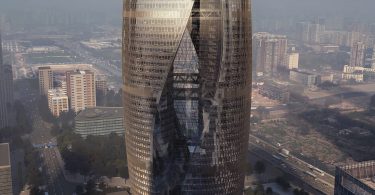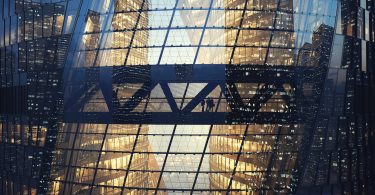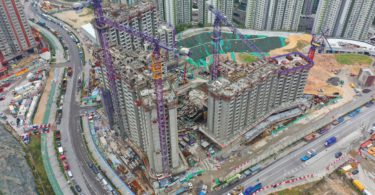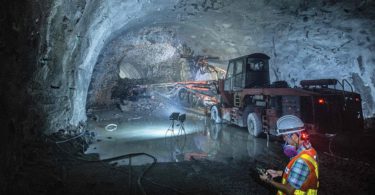Anchoring the Lize Financial Business District—a new business, residential and transport hub adjacent to Financial Road in southwest Beijing—the 46-storey Leeza SOHO will be an attention grabber with its iconic ‘twisted’ structure and soaring central atrium.
The 172,800-square-metre Leeza SOHO straddles a new subway tunnel that diagonally divides the site. Designed by Zaha Hadid Architects, the tower is divided into two wavy halves on either side of the tunnel and connected by a 190-metre-high central atrium—which will be the world’s tallest upon the tower’s completion in late-2018.
Connecting with the city’s bus network on Lize Road and Lou Tuo Wan East Road, as well as the new subway interchange station below, this atrium will be a public space for the new financial district. An outdoor public piazza surrounding the tower, echoing its circular form, welcomes visitors inside.
As the tower rises, the atrium twists at 45 degrees to orientate the higher floors with the east-west axis of Lize Road—one of west Beijing’s main streets. The shape of the atrium creates convex openings on either side of the tower, ushering in natural light and city views from the centre of each floor. Walkways bridge the cavity at different levels.
SCULPTING LEEZA SOHO
The structural system of Leeza Soho is a combination of concrete and steel. “Reinforced concrete has sculptural qualities; it was therefore the ideal choice to realize curvilinear form of the tower,” Satoshi Ohashi, project director of Zaha Hadid Architects, tells Construction+.
“On the other hand, wide-flange steel had long-spanning qualities; it was therefore selected to realise the inter-connecting bridge. This combination enabled Leeza Soho to realize the fluid, dynamic forms, while maintaining construction and economic feasibilities.”
Each of the two halves of Leeza Soho have their own structural core and perimeter columns that follow the curvilinear exterior form of the tower, with steel tension rings surrounding each floor plate. The four aerial bridges that connect the towers are made of wide-flange steel beams and columns, which provide the right strength to resist bending stress and enabled the bridges to span extended distances.
THE CASE FOR ALUMINIUM
“Of all the components that make up Leeza Soho, its façade is arguably the most visually significant,” says Satoshi. “While the building’s structure keeps it standing and MEP ensures its daily functioning, the tower’s façade envelops all components together in a fluid, cohesive whole.” The design team, therefore, committed great effort to the research and development of the façade.
The first challenge was to find the most suitable material. The design team initially rationalised the digital 3D model of the building by dividing the overall shape into individual panels with reasonable dimensions. They then optimised the different panels using an algorithm that searches for shape similarities within the façade to a tolerable degree—minimising the number of different façade panels required, preserving the original curvature quality of the design, while maintain an acceptable level of fabrication and economic feasibility.
During the first round of façade mock-up exercise, different fabricators were invited to build façade mock-ups with different cladding materials—aluminium, form steel, glass-reinforced concrete (GRC), and fibre-reinforced polymer (FRP). These mock-ups were tested based on their material’s ability to express smooth curvilinear geometry, maintain clean edges, and preserve accuracy that is faithful to the original design model.
While FRP, GRC and form steel were all capable of maintaining the characteristics of the original 3D design, only aluminium could deliver the building within reasonable time frame, effort, and budget. The material is durable, and the technology is well established in China. Thus, Leeza Soho became an aluminium-clad building.
QUALITY AND ACCURACY
In the second round of mock-ups, various well-established façade companies from all over China were invited to deliver mock-ups made of aluminium panels with the best overall geometric accuracy and installation quality. The design team was also looking for the best connection bracket and transfer bracket details, for accurate installation and easy adjustments.
Each individual panels are given individual bar code identification to assist with on-site tracking. The designs are created digitally using 3D building information modelling and sent directly to the fabricator. From the first panel to the last, the digital information of every single panel is tracked from the factory for quality and accuracy purposes.
DESIGNING FOR ENVIRONMENT
Both halves of the tower are encased by the double-insulated glass façade in a single cohesive envelope. The glass curtain wall system steps the glazing units on each floor at an angle, allowing ventilating registers to draw outside air through an operable cavity when required. This helps maintain a comfortable indoor environment despite extreme external weather conditions.
Targeting LEED Gold certification, an advanced 3D building information modelling (BIM) energy management system will monitor real-time environmental control and energy efficiency within the development, integrating heat recovery from exhaust air, high-efficiency pumps and fans, chillers and boilers, lighting and controls, in addition to water-collection, low-flow rate fixtures, grey water flushing and landscape irrigation.
Low volatile organic compound (VOC) materials will be installed throughout the tower to minimise interior pollutants, and when required, high-efficiency filters will remove PM2.5 particles via the air-handling system. As part of its sustainability efforts, 2,680 bicycle parking spaces with lockers and shower facilities are provided, along with dedicated charging spaces for electric/hybrid cars located below ground.
PROJECT DATA
Project Name: Leeza SOHO
Location: Lize Road, Beijing, China
Expected Completion: 2H 2018
Project Site Area: 30,688 square metres
Gross Floor Area: 172,800 square metres
Building Height: 46 storeys; 207 metres
Client/Owner: SOHO China Ltd
Chief Executive Officer: Zhang Xin
Competition Project Directors: Satoshi Ohashi: Manuela Gatto
Competition Team Lead Designers: Philipp Ostermaier; Dennis Brezina; Claudia Glas Dorner
Competition Team: Yang Jingwen; Igor Pantic; Mu Ren; Konstantinos Mouratidis; Nicholette Chan; Yung-Chieh Huang
Architecture Firm: Zaha Hadid Architects (ZHA)
Project Architect: Philipp Ostermaier
Executive Architect: Beijing Institute of Architecture Design (BIAD)
Interior Design Firms: ZHA; Huateng
Project Director: Satoshi Ohashi
Project Associates: Kaloyan Erevinov; Ed Gaskin; Armando Solano
Project Team: Yang Jingwen; Di Ding; Xuexin Duan; Samson Lee; Shu Hashimoto; Christoph Klemmt; Juan Liu; Dennis Brezina; Rita Lee; Seungho Yeo
Façade Consultants: KWP (Konstruct West Partners); Kighton Façade; Yuanda
Civil & Structural Engineers: Bollinger + Grohmann (Competition); China Academy of Building Research (CABR); BIAD
Mechanical, Electrical and Plumbing (MEP): Parsons Brinkerhoff
Lighting Consultants: Light Design; Leuchte
Landscape Architects: ZHA; Ecoland
Green Building Consultant: ZHA
Main Contractor: China State Construction Engineering Corporation #3
Façade Contractors: Lingyun; Yuanda
Images: ZHA; MIR; Di Ding; Satoshi Ohashi; Yicheng Yang

 Malaysia
Malaysia Singapore
Singapore Indonesia
Indonesia Tiếng Việt
Tiếng Việt ประเทศไทย
ประเทศไทย





















